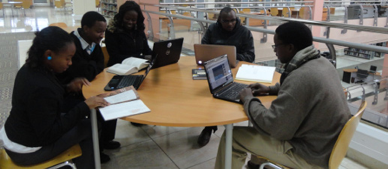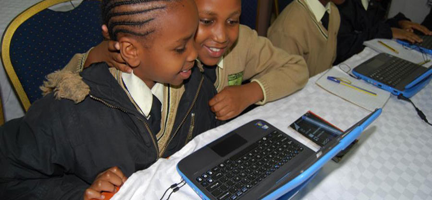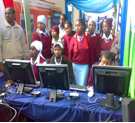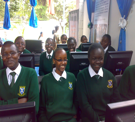
VOL. 2, No. 1
The female population in Kenya was reported at 50.05% in 2011, according to a World Bank report published in 2012. Despite this slightly higher percentage over males, women in Kenya are not well represented in education and training compared to their male counterparts (Kenya National Bureau of Statistics, 2012). The need to empower girls and women through education is vital in order to comply with the Bill of Rights (Constitution of Kenya, 2010). The Use of Information and Communication Technologies (ICT) and Open and Distance Learning (ODL) are two of the initiatives that seek to achieve gender parity in education in Kenya. This paper seeks to do the following with regard to girls’ and women’s education in Kenya: a) establish the implications of ICT and ODL; b) examine the current policies that support the use of ICTs; c) assess the objectives and strategies to facilitate the widespread use of ICTs; d) assess the Implementation of policy objectives and strategies in support of ICTs and ODL ; e) identify priority areas for implementation of ODL initiatives for women and girls’ education in Kenya; f) state lessons drawn from the ICT and ODL initiatives; and g) propose strategies for addressing the challenges for implementation of ODL and ICT. The literature provides very informative findings in support of ICT and ODL for female education. A number of policies and initiatives are operating in Kenya to ensure ICT and ODL are maximized for both genders. However, these policies and initiatives have not fully achieved the objectives for which ICT and ODL ought to be implemented. The needs of girls and women should be factored into a curriculum development strategy concerning ICT and ODL.
Policy makers, planners, administrators and researchers hold highly polarized views on the impact of information and communications technologies (ICTs) and their role in promoting objectives such as poverty alleviation, universal education, reduction in mortality and health hazards, sustainable development and in bridging the digital as well as socio-economic divides in the world.
While rapid technological changes are fast creating what is now known as an `information society,' on the one hand, on the other, there are an estimated 18% of adults, or 771 million, globally, who are still illiterate. Of these, the majority is female, and nearly all are from the poorest sections of society.
In Kenya, the population ratio of women to men is higher, though, this contrasts with literacy levels between men and women. Women seemingly are the majority in the informal sector as compared to men (Kenya National Bureau of Statistics, 2012). In politics, men occupying political seats have higher numbers, hence, they are the major decision makers in parliamentary matters (Kenya elections 2013).
There have been efforts to bridge the social, political and economic gaps between the genders. One of the methods to minimize these gaps is by education through the use of Information and Communication Technologies and Open and Distance Learning. It is with this background in mind, that the present paper was conceived to ascertain what, if any, has been the current role of ICTs in promoting girls’ and women's education, particularly women's literacy, and what challenges face the the further implementation of ICT and ODL. Recognizing that women's illiteracy would further exacerbate the already serious problem of the `digital divide,' it was felt that a review of the literature would help in assessing what new perspectives had emerged during the past few years. It was also felt that field visits to on-going projects in various settings would help in identifying and validating some core principles of good practice in the use of ICTs in literacy programs for women in Third World countries, with a special focus on Kenya. Thereafter, the paper analyses the current status of ICT and Open and Distance learning as it advances girls’ and women’s education in Kenya. The paper also considers initiatives the government of Kenya has put in place, how ICT and ODL is being implemented in Kenya, and questions some of the challenges such initiatives are facing. It also suggests solutions for these challenges.
ICT and ODL are considered means through which equity, access and quality of education could be attained. Gender disparities in terms of economic, social and political opportunities could be dealt with by using ICT and ODL.
The UNESCO Institute for Statistics (UIS) — the official data source that monitors education and literacy targets associated with Education for All (EFA) and the Millennium Development Goals — annually surveys youth and adult literacy and educational attainment. Adult literacy rates concern the population aged 15 years and older, while youth literacy rates cover the population between the ages of 15 to 24 years. The data are disseminated through the UIS Data Centre and featured in publications like the annual Global Education Digest. The table below provides a summary of the main literacy statistics. As part of the EFA goals, the international community has pledged to improve adult literacy levels by 50% between 2000 and 2015. While the number of illiterate persons has fallen over the past decade, 775 million adults – 64% of whom are women – still lack basic reading and writing skills. In 2010, the global adult literacy rate was 84.1%, compared to 89.6% for youth.
Adult literacy rate, total |
84.1% |
Adult literacy rate, male |
88.6% |
Adult literacy rate, female |
79.7% |
Adult illiterate population, total |
775.4 million |
Adult illiterate population, female share |
64.1% |
Youth literacy rate, total |
89.6% |
Youth literacy rate, male |
92.2% |
Youth literacy rate, female |
87.1% |
Youth illiterate population, total |
122.2 million |
Youth illiterate population, female share |
60.7% |
Source: UNESCO Institute for Statistics, September 2012.
The region of South and West Asia is home to more than one-half of the global illiterate population (52%). In addition, 22% of all illiterate adults live in sub-Saharan Africa, 13% in East Asia and the Pacific, 6.5% in the Arab States and 4.7% in Latin America and the Caribbean. It is estimated that less than 2% of the global illiterate population live in the remaining regions combined.
The Arab States and South and West Asia have made the greatest progress in improving adult and youth literacy over the past two decades. Between 1990 and 2010, the adult literacy rate in the Arab States rose from 55% to 75% and the youth literacy rate from 74% to 89%. Over the same period, the adult literacy rate in South and West Asia increased from 47% to 63% and the youth literacy rate from 60% to 81%. To a lesser extent, progress was also observed in all of the other regions.
By 2015 – the target year for Education for All and the Millennium Development Goals – two thirds of adults and three-quarters of youth in sub-Saharan Africa are expected to be able to read and write. Central Asia, Central and Eastern Europe, East Asia and the Pacific, and Latin America and the Caribbean are expected to be at or near universal youth literacy. In the Arab States and South and West Asia, approximately nine out of ten young adults between the ages of 15 and 24 years are projected to be literate. Adult literacy rates are estimated to continue to rise in the coming years but are expected to remain below the youth literacy rate in nearly all regions. The global adult literacy rate is estimated to reach 86% by 2015 and the youth literacy rate 92%.
In order to address the enormity of the problem, the United Nations launched the United Nations Literacy Decade (2003-2012) in 2003. Its aim is to bring literacy to all. The overall target for the Literacy Decade is the UNESCO Education for All (EFA) goal of increasing literacy rates by 50% by 2015.
The Literacy Initiative for Empowerment (LIFE) is a global strategic framework and key operational mechanism for achieving the goals and purposes of the United Nations (UN) Literacy Decade. Because of the established relationship between illiteracy and poverty, the achievement of the Literacy Decade Goals is central to the realization of the Millennium Development Goals. The International Action Plan for implementing the Literacy Decade states that “literacy for all is at the heart of basic education for all and that creating literate environments and societies is essential for achieving goals of eradicating poverty, reducing child mortality, curbing population growth, achieving gender equity and ensuring sustainable development, peace and democracy” (UNESCO, 2002).
With the rapid expansion of ICTs, educational applications of technology could be made available to school-based programmes but there is a strong possibility that, due to scarce resources, the poorest and most marginalized groups would be excluded. There is thus a danger that with the growing importance of ICTs in knowledge-based societies, those groups with little or no literacy will fall even further behind those who are literate. The literacy gap that already exists will therefore grow even wider and, undoubtedly, exacerbate the problem of the digital divide.
If the United Nations Literacy Decade goals are to be achieved, efforts would have to focus on reaching those at the very bottom extreme of the literacy divide, and there needs to be consideration of how ICT can contribute to achieving those goals.
On the basis of national studies that highlight best practices in the use of ICTs for literacy programs, as well as other experiences around the world (particularly in school education) it is claimed that ICTs have potential to enhance learning and broaden access to literacy education and empower learners — especially women.
The Primary to secondary school Transition Rate (PTR) in Kenya is low at 55% (Ministry of Education (MOE) of Kenya, 2010). The Government of Kenya’s (GOK) budgetary allocation for the sector is insufficient and this restricts the provision of resources, such as textbooks and also affects PTRs and Retention Rates. Completion Rates stood at 76.8% (79.2% for boys and 74.4% for girls) in 2010, and these had already declined from the 83.2% of the previous year (88.3% and 78.2% for boys and girls respectively). (Ministry of Education (MOE) of Kenya, 2012)
The transition rate from primary to secondary education increased marginally from 59.6% (56.5% for male and 63.2% for female) in 2007, to 64.1% (61.3% for male and 67.3% for female) in 2008, further increasing to 66.9% (64.1% for male and 69.1% for female) in 2009 and to 72% in 2010.
|
2008 |
2009 |
2010 |
2011 |
||||
|
Boys |
Girls |
Boys |
Girls |
Boys |
Girls |
Boys |
Girls |
Enrolment in Primary ‘000’ |
4,362.5 |
4,201.3 |
4,509.4 |
4,322. |
4,751.9 |
4,629.3 |
4,977.7 |
4,880.2 |
Enrolment in Secondary ‘000’ |
720.5 |
615.4 |
787.9 |
684.7 |
885.5 |
767.8 |
948.7 |
819.0 |
Enrolment in Universities ‘000’ |
73.5 |
49.3 |
110.3 |
67.4 |
107.7 |
69.9 |
17.7 |
80.6 |
Enrolment in Other institutions ‘000’ |
56.5 |
53.1 |
55.1 |
52.2 |
56.4 |
54.7 |
68.5 |
65.3 |
Student enrolment by type of institution and gender (Kenya National Bureau of Statistics 2012). Universities include both public and private universities; other institutions include teachers training colleges, polytechnics and technical institutes.
The state of application of ICTs and ODL to promote gender equity socially, economically and politically has gained momentum. Various initiatives have been put in place to ensure the objective of gender equity is attained. The policy initiatives that have been put in place include the Kenya ICT Policy, 2006; Kenya Vision, 2030; Sessional Papers No 1., 2005; and the Millennium Development Goals.
Kenya ICT Policy 2006
To ensure the deployment of ICTs for education, the ICT Policy, 2006 aims to promote distance education and virtual institutions in higher education and training. Equity in education will be achieved through an integrated e-learning curriculum, development of digital content, establishment of infrastructure and development and sharing of e-learning resources. This will facilitate public-private partnerships to mobilize resources in order to support e-learning.
Kenya Vision, 2030
Girls’ and women’s interests have been recognized through the economic, social and political pillars of Kenya Vision, 2030, which recognizes ICTs as an enabler for these pillars for Kenya. ICTs will play a critical role, ensuring that there is access to equity in quality education. The Government of Kenya, therefore, will seek to establish a computer supply programme that provides students with modern IT skills.
Sessional Paper No 1.,2005
In Sessional Paper No. 1 of 2005, the Ministry of Education’s (Kenya) policy clearly articulates intentions to integrate information and communication technology (ICT) into education. This is intended to ensure that education and training service provision and delivery utilizes modern ICT tools. It should be noted that there are two dimensions to ICT in education—teachers and learners learn about ICT and teachers and learners learn with ICT. Learning about ICT allows learners to contribute to the development of Information and communication technology solutions. Learner’s become producers of ICT solutions. On the other hand, learning with ICT is aimed at enabling learners to acquire knowledge and skills that enable them to use ICT effectively. Learners use ICT as a tool for empowerment. These two approaches have been assimilated into education in Kenya. The Ministry‘s policy is to integrate ICT into education and training in order to prepare the learners and education managers of today for the 21st century’s educational environment and the knowledge economy.
Millennium Development Goals
The Millennium Development Declaration encourages member countries to promote gender equity and the empowerment of women as effective ways to combat poverty, hunger and disease, and also to stimulate development that is truly sustainable. The national development framework lists two key pillars as, investment in the agricultural sector and heavy reliance on the private sector within a liberalized market. Those sectors dominated by women and the poor are at the periphery of the economy and have meagre investment resources. Gross gender inequalities persist due to prevailing discriminatory practices, which lead to inequality in opportunities, wages and employment, ownership of property, and access to education and training. Overall, women continue to have less access to social services and productive resources than men. Women remain vastly underrepresented in parliament and local authorities and account for only 8.3% of the seats in the National Assembly. In the recent past, the government has appointed some women to key positions but the number is still below expectations. There are also large wage gaps and only a small proportion cannot be explained by gender differences in education, work experience or job characteristics.
A recent study in Kenya also indicate that women are highly optimistic, embracing ICT as a practical mechanism for achieving entry into the labour market (Amadi 2007). However, they perceive significant structural barriers, such as public policies that fail to facilitate the development of the ICT sector, gender discrimination by employers, and lack of training to provide them with sufficient technical skills to enable them to effectively perform in the workplace. These findings are largely confirmed by similar studies conducted in other countries (AAUW 2000).
Creating an empowering environment for women to venture into ICT careers as professionals therefore requires that families deconstruct gender stereotypes and roles in society. A similar process is required in important sectors like education and labour, as well as in the workplace and society in general, and is a strategy for shifting people’s thinking, and reducing gender discrimination in the ICT sector, thereby making it more attractive to women who contemplate entering the sector as professionals (Abagi et al 2008). To ensure girls and women attain universal access to education, the following initiatives have been put in place:
Project Africa
Project Africa’s Adult Literacy program is for rural women and looks in particular at the intercultural communication between women in Kenya and Sweden at the Women’s Academy with the aim to empower rural women and girls with literacy skills in the use of both traditional and new media, through education, information, and enterprise development. The project is directed towards rural women in Kenya with connections to other parts of Africa. Hallberg and Wafula (2010), in their presentation on empowering women in Kenya with literacy skills through web 2.0, acknowledge that education is creating a closer sense of interconnectedness amongst women than used to occur in traditional classrooms. Presentations at the conference on ICT (Development and Poverty Reduction) concluded that ICT can be a reminder of the distance and separation from the rest of the world. Women farmers have benefited from communications with other parts of the world about business.
BRIDGE Development
BRIDGE was set up in 1992 as a specialized gender and development research and information service within the Institute of Development Studies (IDS), UK. BRIDGE supports gender mainstreaming efforts of policy-makers and practitioners by bridging gaps between theory, policy and practice with accessible and diverse gender information. Debates around the relationship between gender and technology provide a starting point for a discussion on gender and ICTs.
Kenya Education Network (KENET)
To promote equity and access to Education through ICT, the Kenya Educational Network (KENET), a National Research and Education Network, was formed to promote the use of ICT in teaching, learning, and research in higher education institutions in Kenya. KENET aims to interconnect all the universities, tertiary and research institutions in Kenya by setting up a cost effective and sustainable private network with high-speed access to the Internet. KENET also facilitates electronic communication among students and faculties in member institutions, and shares learning and teaching resources through collaboration in research and the development of educational content.

High-end network equipment for KENET.

KENET has become the first African National Research and Education Network (NREN) to implement eduroam by setting up the service in ten universities within the KENET community. This means that students can now use their university credentials to access wireless Internet services across these universities.
Pasha Centers (Digital Villages)
Women are significant actors in the socio-economic development of any nation (Dlodlo, 2009). To this end, ways of enhancing female access to ICT in rural areas include: women sharing ICT experiences, facilitating ICT access for women, creating an enabling environment for ICT in education, and increasing ICT career opportunities for women (Dlodlo, 2009). Diodlo also stresses the importance of general collaboration in pursuing common ICT objectives. In 2010, the government rolled out an initiative that will diffuse ICT know-how through rural and marginalized areas to address regional disparities. Entrepreneurs, who run Digital Villages, are awarded loans in a competitive process, which they repay over a period of time. Pasha Centres, as the hubs are called, provide a host of services to the public via computers connected to the Internet, or by using and marketing other ICT-enabled applications.
Digital villages are e-centers that provide a suite of services to the public via computers connected to the Internet, digital cameras, printers, fax machines and other types of communication infrastructure. These services include, but are not limited to, e-mail, Internet access, agency banking, e-banking (e.g., money transfer services such as Posta Pay), e-Government (e.g., police abstract forms, tax returns, and driving license applications), e-business (e.g., franchised postal and courier services), e-learning, e-health, e-markets (e.g., agricultural commodity pricing and exchange), and e-monitoring, (e.g., real-time local level monitoring of development funds and projects).

An example of a Pasha centre in Kenya.
Wezesha Initiative
The objective of this initiative is to provide a financial incentive towards purchasing a laptop for registered university students. The laptop initiative is funded by the World Bank and implemented by the Kenya ICT Board under the Kenya Transparency and Communications Infrastructure Project (TCIP), as part of a plan to implement the Computers for Communities Initiative. This laptop initiative is known as 'Wezesha', a Swahili word that means 'to enable'. Many girls and women have benefited from this initiative and advanced their careers. The figure below shows some of the beneficiaries of the initiative in an awareness programme.

Awareness programme in the Wezesha Initiative.
Kenya Institute of Curriculum Development
The Kenya Institute of Curriculum Development is a government statutory body mandated to develop curriculum and curriculum support materials. Some of the latest initiatives by the institute to increase access to learning through open and distance learning include the development of digital content, use of digital educational channels (radio and TV), and the introduction of the Elimika platform to orient primary school teachers. In order to increase access to education at all levels of education except university, the Kenya Institute of Education broadcasts educational content through Channel 8, where content is developed and packaged for broadcasts. A number of schools in remote areas have gained access to this kind of education and girls who perhaps may not have had an opportunity to access education have benefitted from it.
Through e-learning content packaged in CDs and DVDs, adult and continuing education has been enhanced so that female learners have an opportunity to get quality education. The figure below shows an example of the initiatives undertaken by Kenya Institute of Education to improve access to education. This is a project for one class studying at Moi Primary school in Nairobi using laptops

Initiative of the Kenya institute of Education.
Other Initiatives
Other initiatives include Computer for Schools, which provides computers and training. Computers for Schools Kenya is a partnership of communities, private sector corporations, civil society organizations, international charities and development partners working together for the long-term good of the nation. Computer for Schools Kenya has sourced over 100,000 personal computers that have been deployed in over 7,000 public primary and secondary schools, Technical Training Institutes, Teacher Training Colleges, Medical Training Centres as well as several universities. This deployment of computers has assisted many young girls and women to access both formal and non-formal education.
The Kenya ICT Trust Fund has provided ICT equipment for schools. The Trust draws its membership from the government, corporations and regulatory bodies. By tradition, the incumbent Permanent Secretary of the hosting organization chairs the Kenya ICT Trust Fund. The corporations take Vice Chair leadership at the Trust.
The Kenya ICT Trust Fund is core in the formulation and implementation of national ICT Strategy for Education and Training, upon which investment programs in ICT in education in Kenya, is benchmarked. The fund’s main mission is to provide Information and Communication Technology (ICT) resources to facilitate judicious adoption of 21st Century education in Kenya and to move towards the attainment of Quality Education for All (EFA) and the

Millennium Development Goals.

Initiatives of Kenya ICT Trust Fund.
While there have various initiatives that seek to advance the use of information technology among girls and women, several obstacles have derailed the full implementation of ICT and ODL to promote teaching and learning. Lack of clear policy and strategy, uncoordinated players, insufficient integration of ICT in education and limited digital content are to blame for poor adoption of ICT and ODL in education. Other challenges include:
To continue to enhance and empower women in their decision-making, ICT integration in education remains critical where women are carrying out their day-to-day functions. To ensure maximum integration of ICT in education, the following recommendations are offered:
Unless Kenya adopts far more people-oriented education and development policies and strategies, it will likely fail to motivate and attract the majority of women to access and appropriate ICT for their own development and that of their communities. Governments, policy makers, civil society and the private sector and other stakeholders in our country need to be on board and be empowered to take gender into consideration when developing legal and/or policy frameworks regarding ICTs. Therefore, women's equity needs to be integrated as a cornerstone of any ICT strategy.
David Barasa Situma is the Director of Open, Distance and e-Learning in the Department of Academic Affairs at the Africa International University, Kenya. E-mail: barazasituma@yahoo.com